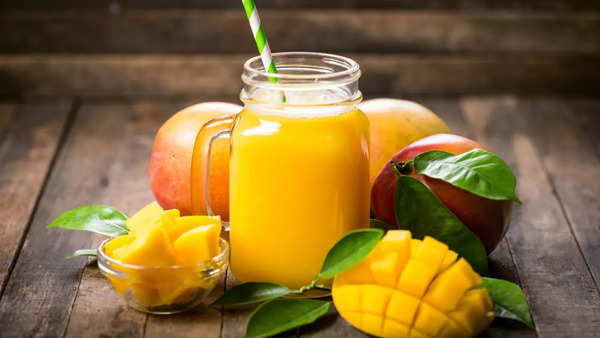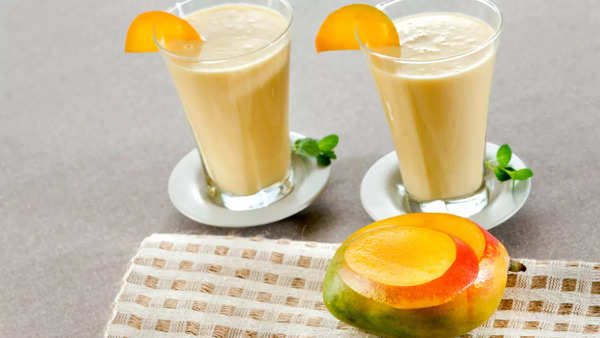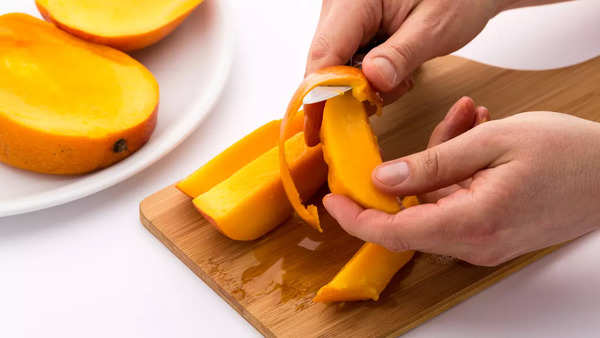Trending
Mango shakes adulterated with synthetic tartrazine dye; Read details inside
Tartrazine yellow, a synthetic food dye, has side effects like urticaria, angioedema, asthma, and genotoxicity in children.

Amidst scorching heat, shakes, smoothies, juices, and water are more than a blessing; they help us stay hydrated and also help fight heatwaves. But what if these beverages turn out to be a cause of illness? Yes, you read right. The use of synthetic colors, chemicals, and pesticides to make these beverages eye-pleasing and tasty has become a common practice, which may lead to major health issues.
In a recent incident, the health department of the Ahmedabad Municipal Corporation found synthetic color in four mango shake samples and other food samples taken over the past week. It is reported that following the lab test, seven food samples were declared substandard, and cases will be filed against all seven shops.
The seven food samples found to be substandard include four mango shakes, one mixed pulse, one fryum, and one chickpea fritter. As per reports, these food items were found to be adulterated with synthetic colors like tartrazine yellow.

Tartrazine is a synthetic yellow food dye and is made from petroleum products. This synthetic color is added to make foods and, of course, drinks look more appealing. It is also called E102, Yellow Lake 69, Food Yellow 4, Arctic Yellow 23, and Trisodium.
What are the side effects of consuming tartrazine?
As per experts, the most common side effects of excessive consumption of tartrazine are urticaria, angioedema (swelling of the lips, tongue, throat, and neck caused by the release of histamine in an allergic reaction), asthma, skin rashes, and food intolerance leading to vomiting. As per a research on the use of artificial food colorings (AFC) in children, it has been found that large doses (50 milligrams or more) cause a greater negative effect on children than on those who received less. It is also said that use of tartrazine is associated with genotoxic (damaging DNA). This damage could cause genetic mutations leading to cancer.

While recognizing tartrazine in mango shake is not an easy task, hence it is suggested to consume whole mango as a fruit and make sure to wash them thoroughly under water before consumption to remove any pesticide or chemical stuck on the outer skin. Also, there are certain ways to find out whether the mango is artificially ripened or not. Take a look at these simple tips and tricks that can help you identify artificially ripened mango.
Check the skin color
Artificially ripened mangoes tend to have a uniform color and may appear more yellow or orange than naturally ripened mangoes. They may also have a slightly shiny appearance.
Smell the mango
Naturally ripened mangoes have a sweet, fruity smell, while artificially ripened mangoes may have a chemical or a different odour.

Check the firmness
Artificially ripened mangoes may feel softer or mushier than naturally ripened mangoes. It happens because the chemicals used in the ripening process can break down the cell walls in the fruit, making them softer.
Look for external damage
If the mangoes have external damage, such as bruises or spots, due to the injection of chemicals, avoid them. Natural mangoes are less likely to have these types of external blemishes.
Conduct a taste test
As per experts, artificially ripened mangoes may have a bland or strange taste. If the mango tastes off or has an unpleasant aftertaste, it may have been artificially ripened.
Also Read: This is how one can identify artificially ripened mangoes at home
Soaking method
Put the mangos in a bucket of water. If the mangoes sink, they are naturally ripened. If they float, they are harvested artificially.
Use baking soda
Add some baking soda to the water, and then soak the mangoes in the mixture for 15-20 minutes. After soaking, once you wash the mangoes, and if the color of the mango changes, there are chances that they are chemically treated or polished.
Also Read:18 types of mangoes enjoy across India
Match stick test
As per the Alphonso Mango website, one can use this test as well. All you need to do is light a match stick and bring it near the box of hafoos, and if it is chemically treated, it may catch fire or leave sparkle traces on the food's surface. This method is very risky; hence, one should avoid trying it at home without taking any preventive measures or in the absence of adults and guardians at home.
Thumb and Embed Images Courtesy: istock
In a recent incident, the health department of the Ahmedabad Municipal Corporation found synthetic color in four mango shake samples and other food samples taken over the past week. It is reported that following the lab test, seven food samples were declared substandard, and cases will be filed against all seven shops.
The seven food samples found to be substandard include four mango shakes, one mixed pulse, one fryum, and one chickpea fritter. As per reports, these food items were found to be adulterated with synthetic colors like tartrazine yellow.

What is tartrazine yellow?
Tartrazine is a synthetic yellow food dye and is made from petroleum products. This synthetic color is added to make foods and, of course, drinks look more appealing. It is also called E102, Yellow Lake 69, Food Yellow 4, Arctic Yellow 23, and Trisodium.
What are the side effects of consuming tartrazine?
As per experts, the most common side effects of excessive consumption of tartrazine are urticaria, angioedema (swelling of the lips, tongue, throat, and neck caused by the release of histamine in an allergic reaction), asthma, skin rashes, and food intolerance leading to vomiting. As per a research on the use of artificial food colorings (AFC) in children, it has been found that large doses (50 milligrams or more) cause a greater negative effect on children than on those who received less. It is also said that use of tartrazine is associated with genotoxic (damaging DNA). This damage could cause genetic mutations leading to cancer.

While recognizing tartrazine in mango shake is not an easy task, hence it is suggested to consume whole mango as a fruit and make sure to wash them thoroughly under water before consumption to remove any pesticide or chemical stuck on the outer skin. Also, there are certain ways to find out whether the mango is artificially ripened or not. Take a look at these simple tips and tricks that can help you identify artificially ripened mango.
Check the skin color
Artificially ripened mangoes tend to have a uniform color and may appear more yellow or orange than naturally ripened mangoes. They may also have a slightly shiny appearance.
Smell the mango
Naturally ripened mangoes have a sweet, fruity smell, while artificially ripened mangoes may have a chemical or a different odour.

Check the firmness
Artificially ripened mangoes may feel softer or mushier than naturally ripened mangoes. It happens because the chemicals used in the ripening process can break down the cell walls in the fruit, making them softer.
Look for external damage
If the mangoes have external damage, such as bruises or spots, due to the injection of chemicals, avoid them. Natural mangoes are less likely to have these types of external blemishes.
Conduct a taste test
As per experts, artificially ripened mangoes may have a bland or strange taste. If the mango tastes off or has an unpleasant aftertaste, it may have been artificially ripened.
Also Read: This is how one can identify artificially ripened mangoes at home
Soaking method
Put the mangos in a bucket of water. If the mangoes sink, they are naturally ripened. If they float, they are harvested artificially.
Use baking soda
Add some baking soda to the water, and then soak the mangoes in the mixture for 15-20 minutes. After soaking, once you wash the mangoes, and if the color of the mango changes, there are chances that they are chemically treated or polished.
Also Read:18 types of mangoes enjoy across India
Match stick test
As per the Alphonso Mango website, one can use this test as well. All you need to do is light a match stick and bring it near the box of hafoos, and if it is chemically treated, it may catch fire or leave sparkle traces on the food's surface. This method is very risky; hence, one should avoid trying it at home without taking any preventive measures or in the absence of adults and guardians at home.
How to make Crunchy okra with mangoes
Thumb and Embed Images Courtesy: istock
End of Article
FOLLOW US ON SOCIAL MEDIA









